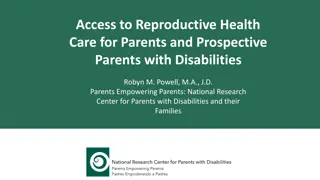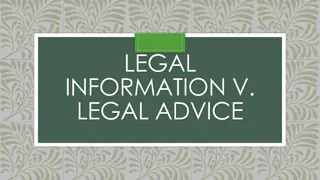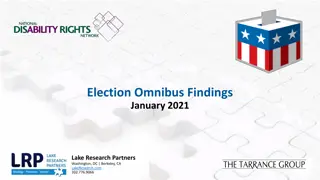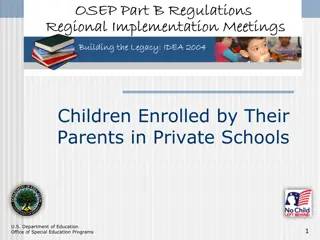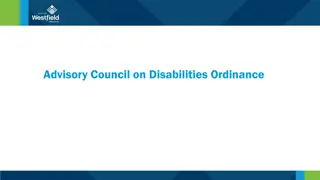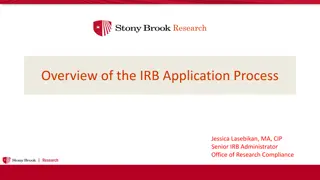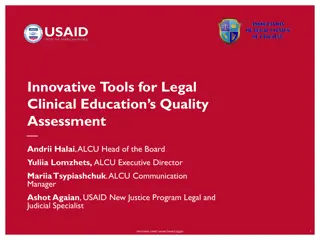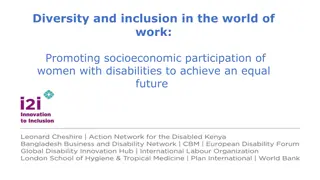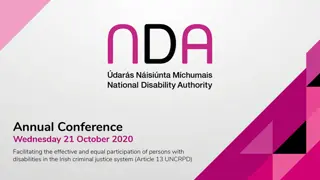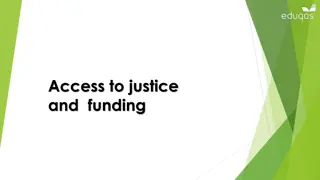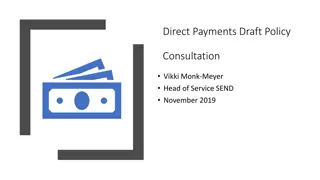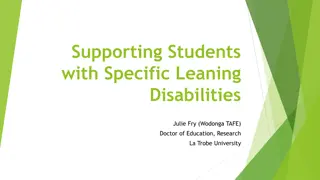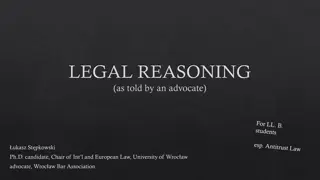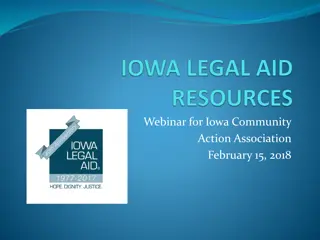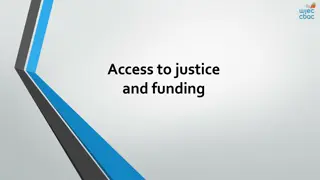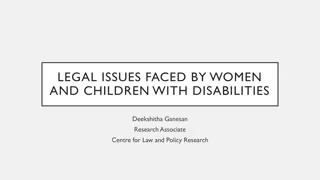Legal Protections for Children with Disabilities
Understanding the legal frameworks of Section 504, the ADA, and IDEA is crucial for ensuring the rights of children with disabilities in educational settings. While IDEA has limitations and only applies to public schools, the ADA and Section 504 offer important protections for children with various disabilities, ensuring access to necessary services and accommodations. These laws fill in the gaps where IDEA falls short, particularly for disabilities that require modifications to the physical environment or medication administration at school.
Download Presentation

Please find below an Image/Link to download the presentation.
The content on the website is provided AS IS for your information and personal use only. It may not be sold, licensed, or shared on other websites without obtaining consent from the author. Download presentation by click this link. If you encounter any issues during the download, it is possible that the publisher has removed the file from their server.
E N D
Presentation Transcript
Sarah Fech-Baughman, American Diabetes Association Seth Packrone, Disability Rights Advocates 2019 Jacobus tenBroek Law Symposium
I. Overview of Section 504 and the ADA II. Hurdles to Enforcing Section 504 and the ADA III. Strategies for Individual and Systemic Reform IV. Relevant Litigation by the ADA and DRA IV. Discussion: Challenges to Enforcing Section 504 and the ADA
The Individuals with Disabilities Education Act ( IDEA ) has important limitations It does not apply to all students with disabilities who need services It only applies to public schools Some services that students need cannot be provided through an Individualized Education Program The Individuals with Disabilities Education Act ( IDEA ) has important limitations:
The ADA offers important protections for children with disabilities: Title II of the ADA s prohibitions against discrimination apply in schools and other settings that provide services to children, see, e.g., 28 C.F.R. 35.130(b)(1), (2) Service Animals 28 C.F.R. 35.136 Cullman County (AL) Schools, 118 LRP 4838 (Sept. 2017) The ADA offers important protections for children with disabilities:
Like the ADA, Section 504 fills in where the IDEA does not apply: 34 C.F.R. 104.31 preschool, elementary, secondary, and adult education programs or activities that receive Federal financial assistance 104.33 FAPE appropriate education is the provision of regular or special education and related aids and services that (i) are designed to meet individual educational needs of handicapped persons as adequately as the needs of non handicapped persons are met and (ii) are based upon adherence to procedures that satisfy the requirements of 104.34 (LRE), 104.35 (evaluation/placement), and 104.36 (procedural rights) Like the ADA, Section 504 fills in where the IDEA does not apply:
Section 504 and the ADA are particularly important for children with certain disabilities: Disabilities that may require modification to the physical environment: Blindness/low vision, disabilities affecting mobility Disabilities that require medication administration during school: diabetes, AD/HD, severe allergy, asthma, epilepsy, cerebral palsy, HIV Section 504 and the ADA are particularly important for children with certain disabilities:
Some of the most important differences between Section 504/ADA and IDEA are: To qualify: 504 person with a disability IDEA person with a disability* who, by reason thereof, requires special education and related services The IEP process vs. the 504 process Procedural protections not as specific under 504 34 C.F.R. 104.36 (Section 504) v. 34 C.F.R. 300.121 (IDEA) Definition of FAPE roughly the same 34 C.F.R. 104.33 v. 34 C.F.R. 300.17 Some of the most important differences between Section 504/ADA and IDEA are:
Despite the importance of Section 504 and the ADA for certain students, they are underenforced: Schools have less expertise and formalized processes for seeking accommodations under these laws In other settings, including childcare centers and summer camps, the lack of formalized due process routes for rights holders contributes to underenforcement Despite the importance of Section 504 and the ADA for certain students, they are underenforced:
State law considerations: Nurse Practice Act: Ambiguous: (CA) Cal. Bus. & Prof. Code 2700 et seq Clear and Restrictive: (MA; NY) N.Y. Educ. Law 6900 et seq; 105 CMR 210.004 State laws in the education or childcare codes creating an exception to the Nurse Practice Act: Can be directed at specific disabilities, medications, or medication delivery routes E.g. Pennsylvania 24 P.S. 14-1414.1-1414.2 (Epi and inhalers); 24 P.S. 14-1414.3 1414.6 (diabetes) Federal preemption arguments State law considerations:
The effects can be devastating for families of children with diabetes: Exclusion of children with diabetes from childcare, summer camps, and school-related activities The burden shifts to parents to provide care, with dire employment and financial consequences Children s health is at risk without services The effects can be devastating for families of children with diabetes:
This is an area of huge need and individual and systemic advocacy are both necessary: Types of individual advocacy include informal demand letters/negotiations, Office of Civil Rights Complaints, and individual due process cases Systemic advocacy includes efforts to change state laws, Department of Justice actions, and impact and class action litigation This is an area of huge need and individual and systemic advocacy are both necessary:
The ADA has clearly laid out guidelines that can be used in individual and/or systemic advocacy: ADA position statements for school and childcare settings fully describe best practices for diabetes care good resource for negotiation and to support expert witnesses Highlights include: 3 levels of training (school setting) In general, nurse coordinating care with lay staff trained to competently watch for issues and step in if nurse is unavailable The more people who are trained, the better (more likelihood of coverage on fieldtrips, through staff changes, etc.) The ADA has clearly laid out guidelines that can be used in individual and/or systemic advocacy:
The ADA can assist you with individual advocacy Staff attorneys available to provide information and referrals to individuals facing discrimination Dir. of Litigation Consult with attorneys litigating on behalf of individuals Connect practitioners with expert witnesses Submit amicus briefs The ADA can assist you with individual advocacy:
ADA and DRA have partnered together on systemic reform efforts: Know-your-rights presentations to parents/other stakeholders Law reform efforts at the state level Targeted negotiation efforts with entities with illegal policies Litigation against national and citywide entities on behalf of children with diabetes ADA and DRA have partnered together on systemic reform efforts:
There are pros and cons to individual reform efforts: Reasonable likelihood of success in the negotiation stage (in the absence of entity/schoolwide policy) Faster route when there are impending health or financial consequences If negotiation fails, arguable need to exhaust under Fry There are pros and cons to individual reform efforts:
There are pros and cons to systemic reform efforts: Seek policy change rather than accommodations to obviate the need for further actions by other students Strong arguments for excusing exhaustion Mootness There are pros and cons to systemic reform efforts:
K.C. v. OConnell O Connell Pair of lawsuits fighting over ambiguity in CA state law about who can administer insulin ADA filed suit with co-plaintiff families (K.C., et al.) to enjoin CA to issue a directive allowing lay staff to administer insulin Settled with the state and school district defendants allowing unlicensed, trained personnel to administer insulin when a school nurse was not available K.C. v. O Connell, 3:05 O Connell, , 304 P.3d 1038 (Cal. 2013) , 3:05- -cv cv- -04077; 04077; ANA v. ANA v. 304 P.3d 1038 (Cal. 2013)
K.C. v. OConnell O Connell American Nurse s Assoc. filed suit in CA state court (ANA), arguing that the K.C. directive violated state law CA Supreme Court ultimately determined state law permitted lay administration of insulin Lessons learned: CA nurse shortage contributed to this victory Nurse shortages exist across the country K.C. v. O Connell, 3:05 O Connell, , 304 P.3d 1038 (Cal. 2013) , 3:05- -cv cv- -04077; 04077; ANA v. ANA v. 304 P.3d 1038 (Cal. 2013)
American Diabetes Association v. US Dept of the Army (formerly M.W. v. U.S. Dep t of the Army) (5:16 pending) DRA filed suit on behalf of the ADA and an individual child (M.W.) challenging the Army s policy not permitting staff to administer necessary care (insulin administration, glucagon administration) in its childcare programs The suit sought a national policy change under Section 504 Given the geographic isolation of many military bases, parents across the country reported having to quit their jobs to provide care for their children American Diabetes Association v. US Dep t of the Army (formerly M.W. v. U.S. Dep t of the Army) (5:16- -cv pending) cv- -04051, N.D. CAL., 2016) (9 04051, N.D. CAL., 2016) (9th thCircuit, Circuit,
ADA v. US Dept of the Army (formerly M.W. v. U.S. Dep t of the Army) N.D. CAL., 2016) (9 In December of 2017, the case was dismissed on standing/mootness grounds An appeal is pending in the 9thCircuit Lessons learned ADA v. US Dep t of the Army (formerly M.W. v. U.S. Dep t of the Army) (5:16 N.D. CAL., 2016) (9th (5:16- -cv cv- -04051, 04051, thCircuit, pending) (cont.) Circuit, pending) (cont.)
M.F., et al., v. New York City Department of Education, et al., 2018) The ADA and DRA filed a putative class action on behalf of the ADA and three individual children who were being denied basic diabetes care at school and school-related activities The Complaint alleges systemic violations of Section 504, the ADA, and the New York City Human Rights Law, including: Failure to have care in place at the start of the year, forcing parents to provide care at school for weeks or even months; Exclusion of students from field trips, school breakfasts, and after-school activities; Forcing students to unnecessarily miss class for routine care; and Failure to train staff to administer diabetes care M.F., et al., v. New York City Department of Education, et al., 1:18 2018) 1:18- -cv cv- -06109 (E.D.N.Y 06109 (E.D.N.Y
M.F., et al., v. New York City Department of Education, et al., 2018) (cont.) Parents are left to fill in the gaps for the school district s failures to provide care: Parents have to be on-call to provide care during the school hours; and Parents frequently have to attend field trips as a condition of their child s attendance Challenges to reform M.F., et al., v. New York City Department of Education, et al., 1:18 2018) (cont.) 1:18- -cv cv- -06109 06109 (E.D.N.Y (E.D.N.Y
M.F., et al., v. New York City Department of Education, et al. 2018) (cont.) Current status: The litigation is stayed while the parties seek to negotiate a settlement through Structured Negotiations Lessons learned M.F., et al., v. New York City Department of Education, et al., 1:18 2018) (cont.) , 1:18- -cv cv- -06109 (E.D.N.Y 06109 (E.D.N.Y
There are legal challenges to individual and systemic advocacy: Widespread ignorance of the law Conflicting state laws and dearth of case law Exhaustion Class certification There are legal challenges to individual and systemic advocacy:
There are practical challenges to individual and systemic advocacy: Underdeveloped Section 504 and ADA processes Identifying impacted students and families Stereotypes about diabetes The urgent need for individualized remedies There are practical challenges to individual and systemic advocacy:
Please contact Sarah at sfech@diabetes.org or Seth at spackrone@dralegal.org to discuss these issues in your state or to share strategies and results. Thank you!

 undefined
undefined








